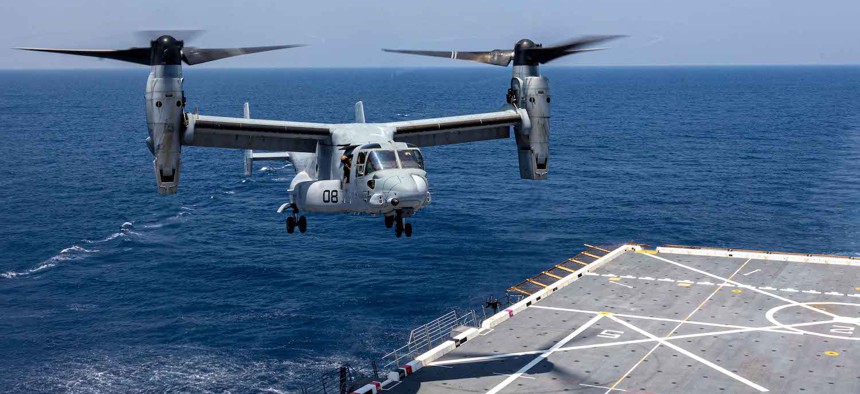
U.S. Marines from VMM-744 Marine Medium Tiltrotor Squadron land a MV-22 Osprey onto the San Antonio-class amphibious transportation dock USS New York, June 29, 2023. U.S. Marine Corps / Lance Cpl. Christian Salazar
Groupthink gives V-22 a bad rap
The tiltrotor’s safety record is on par with other Pentagon rotorcraft—none of which can match its capability and performance.
The V-22 has long gotten a bad rap. As soon as reports of a fatal accident involving an Osprey off the coast of Japan hit the internet last fall, the critics pounced, and a chorus of uninformed skeptics began posting and commenting, all asking: “Why is the Osprey still flying?”
Supporters of the V-22 are quick to point out that the data tells a completely different story. In fact, the Osprey is a modern marvel in terms of performance and capability, and its operational safety record is on a par with the most widely used conventional rotorcraft flying in the Department of Defense today.
Like all first-generation cutting-edge technologies, the introduction of the world’s first tiltrotor aircraft was a learning experience for everyone involved. During initial development, the program suffered several tragic accidents including the loss of 19 Marines during an operational test flight in 2000. That accident, more than any other single occurrence, damaged the reputation of the program. And, in the decades since then, the V-22 has been subjected to an overwhelmingly negative barrage of public opinion.
But facts matter, and the data shows the 10-year average mishap rate for MV-22s is 3.43 per 100,000 flight hours. For context, that places the Osprey’s mishap rate squarely in the middle of the other type/model/series aircraft currently flown by the U.S. Marine Corps. Examined another way, in the 17 years since the aircraft was first introduced into operational service in 2007, there have been 14 loss-of-aircraft mishaps across all three services and one international partner that operate the aircraft—or .82 mishaps per year while flying over 500,000 flight hours.
Of course, every loss of aircrew and aircraft is a tragic reminder of the difficult challenges military aircrews face every day. In the case of aircraft like the V-22 that carry passengers, an accident often involves injury and loss of life for more than just the aircrew making the impact even greater. However, even by the metric of sheer number of deaths within the first 30 years of operation, the V-22 is safer than other rotorcraft in its class.
For example, a recent article published by Atlas News points out that since the Black Hawk’s introduction in 1979, U.S. H-60 variants have suffered 390 incidents resulting in 970 deaths. Sixty of those deaths have occurred just in the past decade, meaning the H-60 has been responsible for two more deaths in the past ten years than the V-22 over the past 30 years. The same article looked at rotorcraft mishap rates and found that among rotorcraft that routinely carry passengers, the H-47 Chinook—over a 39-year period from 1966 to 2005, 238 people lost their lives in ten individual H-47 non-combat accidents, and the early record of the USMC H-46 Sea Knight is even worse.
These comparisons are not meant to elevate the V-22 above other military aircraft that carry passengers or excuse the Osprey’s safety record in any way. No aircraft is perfect and every aircraft accident, especially one that results in the death or injury of a service member is a horrific reminder of the dangers our military men and women face in service to our nation.
However, the factual data supports the idea that the V-22’s safety record is not an unusual outlier and the perception that the Osprey unnecessarily places service members’ lives at risk is a fallacy resulting from groupthink.
Groupthink is a phenomenon in which a group of individuals come to a consensus without critical reasoning or considering the consequences or alternatives. The problematic or premature consensus that is characteristic of groupthink may be fueled by a particular agenda—or it may be due to group members valuing harmony and coherence above critical thought.
Tiltrotor technology is still relatively new, and the V-22 is the first generation of its kind. Yet the V-22 is among the safest aircraft in the U. S. inventory today. Instead of asking why V-22s are still flying, maybe the critics should ask why we aren’t holding all aircraft to the same standards of performance?
With the U. S. Army recently choosing the V-280 Valor tiltrotor over the SB-1 Defiant coaxial helicopter to replace the H-60 line, it’s clear that the Pentagon has no plans to shelve tiltrotor technology. That’s because of the incredible advantage provided by the tiltrotor’s improved speed and range. Tiltrotor technology is simply a quantum leap in capability over conventional rotorcraft, and a necessity for our armed forces.
Bottom line, V-22 Ospreys provide warfighting commanders operational lethality, mission-flexibility, and surprise they need through the application of tiltrotor’s superior speed, range, payload, and survivability. It’s time to stop the groupthink and face the facts.



